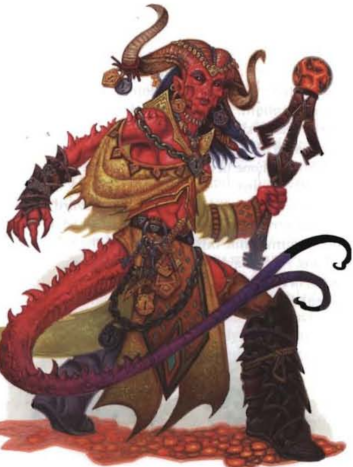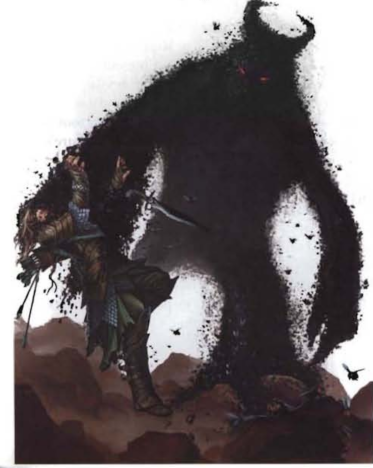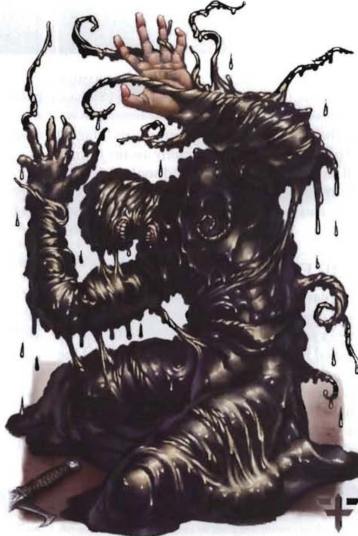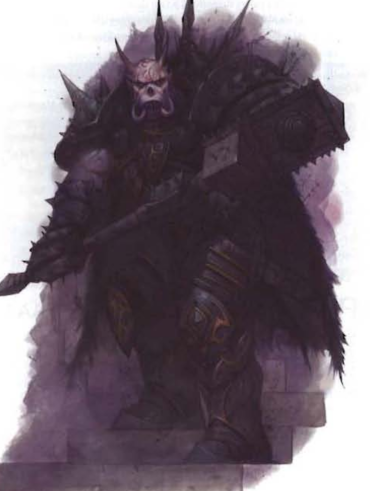Posts
-
Let's Read the 4e Monster Manual 3: Dragon, Catastrophic
I’ve talked a lot about dragons, and why I like their 4e implementation, over the course of these book readings. Sometimes it feels like no big D&D bestiary is complete without introducing a new dragon subtype.
The Monster Manual talked about the classic chromatics, which were then updated on the Monster Vault. You can see what I wrote about them here.
The Monster Manual 2 talked about the equally classic metallics, and you can read what I wrote about them here.
The Monster Manual 3 introduces the much less famous and much newer Catastrophic Dragons. I believe they are new to 4e, though they might also have shown up in some late supplement for a previous edition. You might already have noticed I’m a bit lazy when it comes to researching monster publication histories.
What I’m sure about is that these are the first 4e dragons that have the “correct” math from the start. They’re also notable for being generally weaker than chromatics and metallics despite the impressive name. Your typical catastrophic dragon is an Elite monster rather than a Solo.
The Lore
As we saw in previous articles about dragons, when the god Io was split in two during the Dawn War his followers also split along ideological lines based on which of the two new deities they preferred: Tiamat the greedy or Bahamut the just. I imagine the initial decision was easy for most of them.
For most, but not for all. Some of Io’s orphaned followers were gripped by fear when they saw how easily their lord had been slain, and they decided that the best way to survive would be to beseech the Primordials for protection and join their side of the Dawn War. These turncoats were transformed by the “blessings” of the Primordials into the first catastrophic dragons.
When the Primordials were defeated most surviving catastrophics scattered across the multiverse and turned to their own selfish purposes. The typical catastrophic in the present day is somewhat less formidable than a chromatic, but more outwardly destructive. They tend to live in extremely hostile environments that befit their individual natures, and from the point of view of surrounding civilians their behavior looks a lot like that of a natural disaster: they occasionally emerge to wreak havoc and destruction on people and their environment, and then return to their lairs for an unknown amount of time.
Legends and myths dating back to the Dawn War tell of catastrophic dragons of immense size and power, capable of sinking continents and destroying entire astral domains. No one knows whether these stories are true, and even the gods refuse to tell.
The Dragons
This entry is structured a lot like previous dragon entries, with each type of dragon presented getting stat blocks for all of its age categories. That’s about where it stops, though. Catastrophic dragons are more like personified natural disasters than like the traditional dragons we saw in previous books.
The ones we see here are clumsy fliers, and even lack the traditional breath weapon! Instead, they’re surrounded by an aura that’s like a miniature version of the disaster they embody. During a fight, this aura grows in size as time passes and then explodes in a, well, catastrophic manner before returning to its initial size and beginning the cycle anew.
Despite having bodies largely made up of elemental matter, these dragons lack any elemental resistances. Instead, damage of their associated type triggers a reaction ability that punishes the attacker in some form. I would however say that they are immune to environmental damage of their associated type even though that’s not made explicit in their stat blocks, because it just wouldn’t do for a blizzard dragon to die of frostbite.
The last major mechanical difference between these dragons and their predecessors is that catastrophics are Elites instead of Solos. Whether this is just bad luck or a punishment from the gods, it means that fights against them will include a bigger supporting cast of other monsters.
There are more age categories here than in the previous books: Wyrmling, Young, Adult, Elder and Ancient. Wyrmlings are Medium in size, and are regular monsters instead of Elites. Young’uns and Adults are Large, and the last two are Huge. I guess a wyrmling isn’t quite a “baby dragon”, but I’d still be a bit wary of placing them as enemies, as I commented earlier.
Despite their thematic link to natural disasters and their destructive demeanor, catastrophic dragons are typically Unaligned, which says interesting things about their mindset.
-
Let's Read the 4e Monster Manual 3: Devil, Vizier

Copyright 2010 Wizards of the Coast This post is part of a series! Click here to see the others.
I don’t remember seeing these specific devils in earlier editions, but that might just mean they were from a late 3e book.
The Lore
This is not the first silver-tongued manipulative devil we’ve seen, not by far, but it seems to be the most specialized one. Vizier devils are rarely found in the Nine Hells - they’re always out in the world serving and tempting ambitious mortals.
Like all other MM3 devils, the lore text on this one is a bit obsessed with sin and with the idea that sinners going to hell and becoming devils is a natural occurrence, which isn’t really something that was present in earlier 4e monster books. As we saw in previous readings, in 4e Hell is a cosmic aberration. Devils don’t come from sinners, and they get their souls either by having mortals sign contracts or through force. Those souls get used as currency, fuel, and magic item ingredients, not to make new devils.
This makes these creatures members of Hell’s sales department, just like imps. The main difference is that viziers are stronger, smarter, and bolder in their suggestions. I imagine having a bound vizier devil instead of a mere bound imp is a major status symbol among deluded diabolists.
If you’re into the sin thing (which was the standard in 3e and maybe earlier), they you can go with the lore in this entry that says that vizier devils are genuinely helpful at first but then begin to steer their “masters” down more evil and sinful paths with the goal of making them go to Hell after they die.
If you prefer the standard 4e lore, then the main difference is that vizier devils will try to get their masters to sign a soul contract either as a pre-condition to their service, or as an “upsell” in exchange for greater power or greater hellish support at some point after they begin their work as advisors.
A 4e-style, contract-based vizier devil is ironically less treacherous than the temptation-based 3e-style one. Their mortal bosses are likely to already be evil in the first place, so they need little tempting. And after the contract is signed there is even less need for deception, as the devil already got what it wanted and only needs to fulfill its part of the bargain.
Vizier devils look like tieflings with slightly exaggerated fiendish features, and that actually makes them good at blending in. In combat, they’re spellcasters with a repertoire focusing on fire and charm magic. They always have a contingency plan or two to escape if the fight goes against them, and never fight to the death if they can help it.
The Numbers
Vizier devils are Medium Immortal Humanoids (devils), and Level 7 Controllers (leaders). They have Resist Fire 10, Darkvision, a ground speed of 6, and a teleport speed of 4. That’s more or less the same set of traits as a legion devil, so maybe they’re related.
They wield Scepters that work as implements and can be used to bash people in melee. This does physical damage and slides the target 1 square on a hit. Their basic ranged attack is a Helfire Bolt that does fire damage and forces the target to grant combat advantage for a turn.
They can also use a Word of Command at will, which lets them choose a creature within 2 squares, slide it 3 squares and have it make a free melee basic attack against another creature of the devil’s choice. The text says “a creature”, which means this can target either an ally or an enemy with this. And the thing is an effect, not an attack, which means it works automatically.
Word of Command does require a standard action, but it’s still a good choice if the vizier is accompanied by big bruisers or if the party includes PCs with good basic attacks. It’s even better if the party includes some of those Essentials martial classes, since they’re all about having awesome melee basic attacks with all sorts of special riders.
The vizier’s leader-ish abilities are Hellfire Enchantment and Infernal Advice. The first is a minor action that grants an ally within 5 squares a +5 fire damage bonus to all its melee attacks until the end of its next turn. The other is a reaction that allows an ally to reroll a missed attack with a +2 bonus. Hellfire Enchantment is an awesome ability to use on allies that have multiple attacks on their turns! All of them will get the bonus.
Final Impressions
I’m not gonna lie, these devils feel a bit redundant. Their concept is exactly the same as all the other sly manipulators, and the only difference is their power level. They’re the “level 7 sly manipulator”, where imps are “level 3” an the others are stronger. I also don’t like the emphasis on sin in this book, because it’s a 3e-ism.
That said, a vizier devil’s stats make it an interesting monster to fight and they can easily be reskinned into infernal warlord types. They go really well with melee bruiser monsters that can make multiple attacks. Those can be part of the entourage of their mortal bosses, or other devils.
-
Let's Read the 4e Monster Manual 3: Devil, Swarm

Copyright 2010 Wizards of the Coast This post is part of a series! Click here to see the others.
This is another devil that breaks the “morphology” guidelines, but it’s kind of unavoidable this time. After all, they’re associated with Baalzebul, Lord of the Flies.
Each swarm devil is a singular mind controlling the bodies of an entire swarm of acidic fiendish flies. According to the book, they’re formed when an angel is caught lying to its divine master and is torn apart as punishment. The angel’s soul falls to the Hells and the bits of its body become flies. They roam the stagnant pools of Maladomni, the Seventh Hell, eternally starving but unable to die. They can only leave when their master orders them on a mission, which makes them very happy because it allows them to fly free and eat people for the duration. It helps that “eating people” usually is the mission. It’s what swarm devils do best, after all.
Swarm Devils fight by just kinda walking into enemies’ spaces and letting their flies do the work, and by spewing flies at people they can’t easily reach that way. As swarms, they’re hard to fight unless you have area-effect weapons and spells.
The Numbers
These creatures are Large Immortal Magical Beasts (Devil, Swarm) and Level 18 Skirmishers with 174 HP. They have Darkvision and a flight speed of 10 (hover), and 20 acid resistance.
They also have the standard swarm traits on top of that: half damage and immunity to forced movement from melee and ranged attacks; Vulnerable 10 to close and area attacks; a swarm aura; the ability to occupy the same space as other characters; and the ability to squeeze through small openings without slowing down.
Their Swarm Attack aura (1) deals 10 acid damage to enemies caught inside. I think being in the same space as the swarm also counts as being inside the aura. Their basic Slams do no immediate damage, and inflict 10 ongoing acid damage.
They can channel Acidic Curses through their acid, targetting someone taking ongoing acid damage with a ranged attack that deals psychic damage and inflicts a -2 penalty to attacks for a turn. Twice per encounter they can Spew Flies in a Close Burst 3, inflicting ongoing acid damage and forcing targets to grant combat advantage (save ends both).
The “just walking into people” tactic is represented by Swarm Shift (recharge 5+), in which it shifts its speed and deals 15 acid damage to anyone they pass through.
A good tactic for them is to move in, hit a few people with the slam or spew, use Swarm Shift to move out of the scrum and keep flinging curses at anyone who’s melting. Reapply the acid as necessary.
Final Impressions
Fly-themed fiends for the Lord of the Flies, nothing unexpected. The acid/psychic damage mechanic is mildly interesting.
-
Let's Read the 4e Monster Manual 3: Devil, Slime

Copyright 2010 Wizards of the Coast This post is part of a series! Click here to see the others.
This is another one of those monsters that’s all about blurring the lines between fiends. These monsters are devils, but they break the design rule that says devils have a human-like appearance.
Slime Devils are amorphous oozes, though unlike most “true” oozes they’re sapient and rather smart. They probably originated in some past edition as well, because they’re the second devil said to be formed from the souls of dead sinners (which is not a 4e thing). They arise from the mixture of the toxic mud in the swamps of Minauros with the hatred that seeps from the souls of corrupt inquisitors who are stuck there. Their abilities make them adept interrogators and torturers, since they can read the minds of people they envelop and inflict intense pain on them.
They’re often summoned to act in this capacity by villains in the world, so they’ll be found alongside those villains’ guards and jailers. In Hell, they travel with burlier devils, and with those whose controller-y powers can hold enemies down to be engulfed.
The Numbers
A Slime Devil is a Medium Immortal Humanoid (Devil, Ooze), and a Level 16 Lurker with 123 HP. The lore does say their base form is vaguely humanoid, but still I’d probably classify them as Magical Beasts instead. Either way, it doesn’t change their other stats.
They have Darkvision, ground and swim speeds of 6, and Resist Acid 20 instead of the usual devil fire resistance. Their Mercurial Body trait allows them to ignore difficult terrain and not provoke opportunity attacks when moving. They’re still vulnerable to a Fighter’s Combat Challenge or other similar abilities, but non-defenders can’t hold them in place.
Their basic attack is a Caustic Slam that targets Fortitude and does acid damage. They can also stretch into Acidic Tendrils that attack up to three creatures at Reach 3, deal immediate and ongoing acid damage, and pull them 2 squares.
The slime devil’s main trick is Diabolical Engulfment, which targets reflex and grabs on a hit. Grabbed targets are dazed and take ongoing 10 acid damage while the grab lasts. The creature occupies the same space as the victim, and pulls the victim along when it moves. Attacks that hit the slime devil deal half damage to it and half damage to the victim.
As a minor action (1/round), the slime devil can use Scour the Mind on its grabbed victim. This targets Will. On a hit, the devil poses a question to the victim, who must choose between answering truthfully and taking psychic damage. The amount of damage is the same as a basic attack, which is a lot for a minor-action power. The creature can do this and still use its basic attack to fight off the victim’s friends.
Final Impressions
Lore-wise, kinda meh. I’m not a fan of bringing the old “fiends come from the souls of sinners” cliches back into D&D. They’re more interesting mechanically, because I love attack powers that force PCs to choose between two bad outcomes.
-
Let's Read the 4e Monster Manual 3: Devil, Rage

Copyright 2010 Wizards of the Coast This post is part of a series! Click here to see the others.
Looks like the Monster Manual 3 is all about blurring the lines between fiends. We have a devil who became a demon lord, demons who became devils, and now a devil who behaves like a demon. I haven’t run into rage devils before. If they appeared in previous editions, it must have been in a late MM or a specialized supplement.
The Lore
A Rage Devil is what happens when you take a standard Hell Knight and inject demon ichor into it. They’re hulking brutes who are constantly angry and delight in carnage. In other words, they’re pretty much demons, or they would be if their flesh wasn’t bound with empowered Supernal sigils that keep them pointed in the right direction.
These creatures are the result of an infernal experiment to create more powerful shock troops to throw into the meatgrinder of the Blood War. They’re actually a little weaker than a standard hell knight, making them a bit of a failed experiment. Maybe they adapted the process for the mass-produced version so it works on legion devils instead.
Rage devils are used as heavy elements attached to legion devil forces, and are often placed under the command of hell knights. In their free time, these things roam Avernus in search of demon stragglers or anyone else they can get away with smashing.
The Numbers
Rage Devils are Large Immortal Humanoids (Devils), and Level 11 Brutes with 138 HP. They have Darkvision and Resist Fire 20, but they can’t fly. Their ground speed is 6.
These devils are heavily armored and fight with Disrupting Mauls whose basic attacks strip all of the target’s resistances for a turn! They have a special technique named Demonscourge Crush (recharge 4+), which deals the same damage as a basic attack, weakens, and strips all resistances (save ends both). Another maneuver is Maul Storm an at-will Close Burst 2 that deals some damage and pushes targets 3 squares. If they’re bloodied, they’re also knocked prone.
Their Blood Rage passive trait makes them deal extra damage on all attacks against bloodied opponents.
Final Impressions
Rage devils are indeed an excellent weapon both against demons and against other devils, as well as any creature type that relies on high elemental resistances. Behavior-wise they tend to be on the shallower end of the demon cliche pool, with only their binding rituals preventing them from turning on their devilish masters.
As I said above, I’d probably say most rage devils are modified legion devils, because baseline Hell Knights are both stronger and smarter than these things, so turning a Hell Knight into a Rage Devil is a bit of a waste.
subscribe via RSS